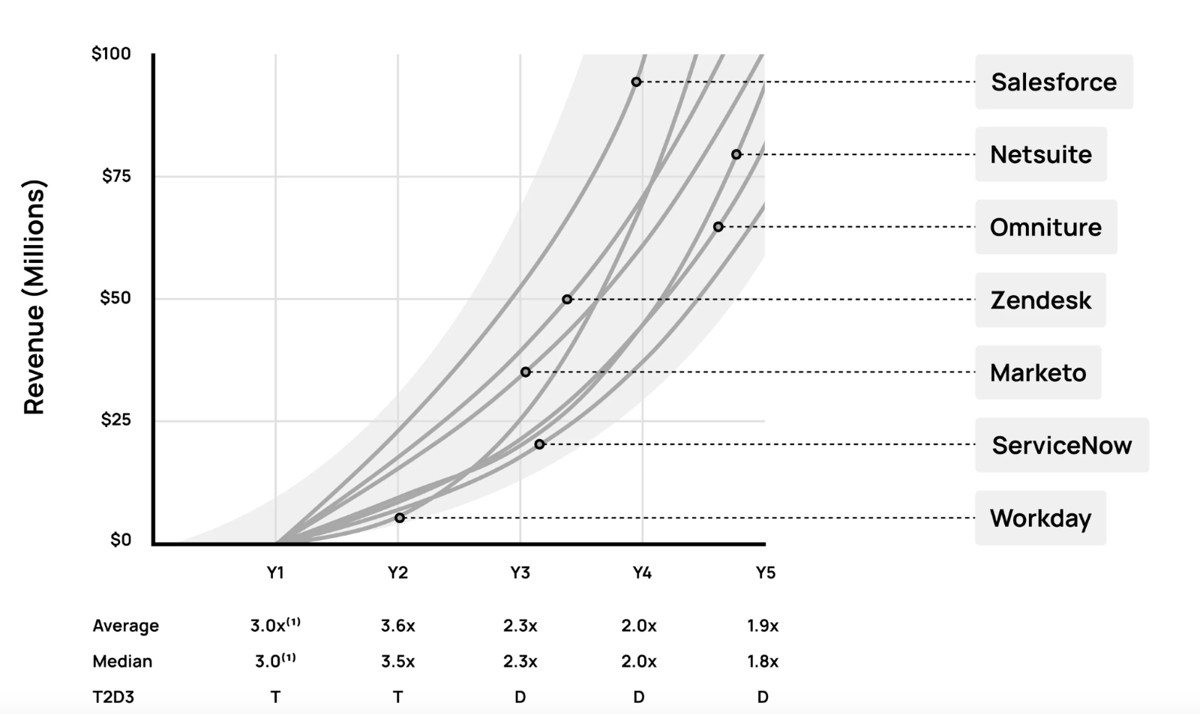What is the T2D3 Method?
T2D3 stands for 'Triple twice and Double three times' your ARR to hit the $100 million mark as a startup. Introduced by SaaS investor Neeraj Agrawal in 2015, this growth pattern is the target for every B2B SaaS company. While investors aim for the next unicorn, achieving a $1B valuation within five years is both a challenge and a rarity. Tripling your ARR for the first two years and then doubling it for the next three years to reach $100M ARR doesn't happen by accident. Companies that accomplish this feat follow a similar journey, encapsulated in the T2D3 methodology.

Getting to MVP – The First Stage
Before embarking on the T2D3 journey, ensure you have a Minimum Viable Product (MVP). This is the simplest version of the product you can sell, aimed at getting your first paying customer. The MVP should solve the primary problem of your end user and validate whether there's value in your product before you fully invest in development.
Marketing Focus at MVP Stage:
- Strategic Messaging: Focus on what the product is for and its positioning.
- Sales-Led Growth: At this stage, the founders are the primary salespersons.
- Defining ICP: Begin testing to find and define your Ideal Customer Profile (ICP).
Pricing at MVP Stage:
Position your product at a lower price point or offer it for free initially, as pricing may not be a significant factor at this stage.
Important KPIs:
- Marketing Qualified Leads (MQLs): The number of leads that meet the defined criteria for a potential customer.
- User Engagement: Track how often and in what ways users interact with the product.
- Customer Retention: Monitor how many customers stay with your product over time.
Getting to PMF – Second stage
Reaching Product-Market Fit (PMF) means you have developed a SaaS solution that meets the needs and demands of a specific market segment. You've found your Ideal Customer, the companies you can and want to serve well. At this stage, your organization is likely generating between $1M to $10M in ARR with approximately 30+ employees.
Marketing Focus at PMF Stage:
- Build a Marketing Team: Assemble a small team including a T-shaped Marketing Leader, Copywriter, Product Marketing Manager, Performance Marketer, Graphic Designer, and Marketing Intern.
- Tactical Marketing focus: Actively contribute to demand generation through tactical initiatives and pass leads to sales.
- Focus on ICP and Value Proposition: Work with sales leadership to refine your ICP and value proposition, adjusting your messaging to focus on who the product is for and how it makes their lives easier.
Pricing at PMF Stage:
At this stage, your product pricing should be sufficient to cover your Customer Acquisition Cost (CAC).
Important KPIs:
- Lead Velocity Rate (LVR): Measure the growth rate of MQLs in your pipeline.
- Reduce Churn: Implement nurturing and retention programs to increase Lifetime Value (LTV) and keep customers longer.
- Improve ARPU: Focus on upselling and cross-selling to increase the Average Revenue Per User (ARPU).
T2D3 – Third Stage – Time to Scale!
Upon hitting PMF, the clock is ticking to scale. At this stage, revenue ranges from $10M to $50M ARR, with a team size of approximately 300 FTEs. Growth is driven by customer retention, demand generation, and ARPU growth.

Marketing Focus at T2D3 Stage:
- Implement a Go-to-Market Strategy: Identify specific growth strategies, including pricing optimization and cost-to-service evaluation.
- Strategic Marketing: Sales-led growth should take precedence, particularly in mature markets where lead generation becomes expensive and if your initial growth strategy is fueled by marketing and service led growth with an ACV (Average Contract Value) of around 10k per year.
- Optimize Team and Processes: Recruit and develop the right team, streamline pricing strategies, and adjust your market segments as needed.
Yearly Targets and Strategies
Year 1: Triple from $1.5M to $4.5M ARR
- Focus: Implement focused marketing and sales using your understanding of ICP.
- Key Metrics: MQLs, Conversions, and CAC.
- Strategies: Real marketing and sales efforts, product-led growth if ACV/ARPU is low (round 1k per year per customer), optimize positioning, and drive demand generation.
Year 2: Triple from $4.5M to $13.5M ARR
- Focus: Consolidate revenue base and reduce customer churn.
- Key Metrics: Churn, MQLs, Conversions, and CAC.
- Strategies: Leverage substantial new business from referrals, maintain a growing recurring revenue stream, and optimize lead conversion rates.
Year 3: Double from $13.5M to $27M ARR
- Focus: Increase ACV and drive ARPU expansion.
- Key Metrics: Churn, MQLs, Conversions, CAC, and ARPU.
- Strategies: Upsell and cross-sell, split sales efforts into new business and account management, and drive demand generation from multiple channels.
Year 4: Double from $27M to $54M ARR
- Focus: Reduce funnel friction and customer acquisition costs.
- Key Metrics: Churn, MQLs, Conversions, CAC, ARPU, Partners, and People.
- Strategies: Optimize marketing-sales handoff, secure a #1 position in subsegment niches, recruit A-level talent, and consider adding a channel strategy.
Year 5: Double from $54M to $108M ARR
- Focus: Expand ICP and explore market expansion or M&A activity.
- Key Metrics: Churn, MQLs, Conversions, CAC, ARPU, Partners, and People.
- Strategies: Consider going global, entering adjacent industries, expanding the solution portfolio, and potentially acquiring more ARR through mergers and acquisitions, ect.
$100M ARR – The Final Stop of Your Startup Phase
To unlock the potential $1 billion unicorn valuation, shift focus from T2D3 exponential revenue growth to driving profitable growth, adhering to the Rule of 40. This means combining your compound annual growth rate and profitability to achieve at least 40%.
Focus Shift:
- From CAC to CTS: Move focus from customer acquisition cost to optimizing cost-to-service (CTS).
- Sustainable Growth: Manage CTS effectively, especially if growth was driven by high customer success resources.
- Profitability: Combine continued revenue growth with profitability to meet the Rule of 40.
Conclusion
The journey to $100M ARR and beyond is steep and challenging, as documented in the McKinsey study 'Grow Fast or Die Slow.' Achieving and maintaining a steep growth curve is essential in the winner-takes-all dynamics of B2B SaaS. Managing multiple growth levers simultaneously is crucial for T2D3 success, transitioning from laser-focused priorities at PMF to managing broader growth strategies.
Key Takeaway: Implementing the T2D3 method requires a combination of strategic planning, tactical execution, and continuous optimization to navigate the SaaS growth journey effectively.
By following the T2D3 method and focusing on the right marketing strategies at each growth stage, SaaS startups can increase their chances of joining the elite 3% that reach $100M ARR.
Interested? Subscribe to my mentorship plan
If you'd like to apply this method to your SaaS startup and accelerate your growth journey, subscribe to my mentorship plan or book an introductory call today. Let's turn your vision into reality!







